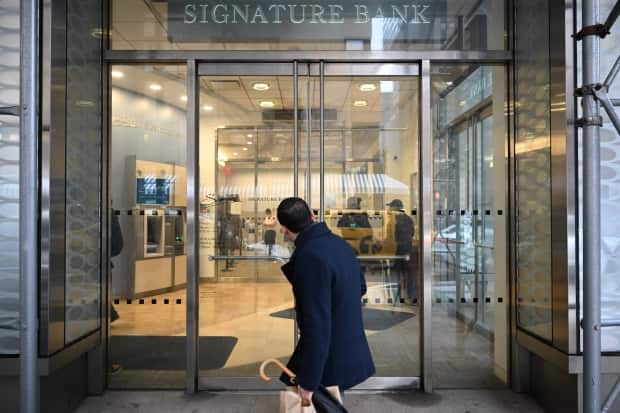Following U.S. bank failures, is it time for Canada to raise deposit insurance limits?

First came the bank run, then the demise, of California-based Silicon Valley Bank two weeks ago. Soon after, New York-based Signature Bank also collapsed.
These back-to-back episodes — the second- and third-largest bank failures in U.S. history, respectively — compelled American officials to act publicly to prevent a broader financial crisis.
"We are taking decisive actions to protect the U.S. economy by strengthening public confidence in our banking system," officials from the U.S. Treasury, Federal Reserve and Federal Deposit Insurance Corporation (FDIC), said in a joint statement after the headline-making bank failures.
These actions included guaranteeing all of the failed banks' deposits, including those far exceeding FDIC deposit-insurance limits.
Deposit insurance protects people's money in the event of a bank failure. In the U.S., the FDIC covers up to $250,000 US per depositor, for each FDIC-insured institution, and per eligible category of account.
But for the Silicon Valley and Signature cases, authorities opted to fully protect all affected depositors — even those with millions of dollars in deposits, which normally wouldn't be entirely insured.

Canadians watching these events may have questions about their own level of protection from bank collapse-related calamity.
Banking experts say such failures are less likely to occur here, owing to a range of factors including: stricter regulations and a set of big, well-capitalized banks at the core of the sector.
"While a bank is a bank, underneath the covers, a bank is very different in the United States as it is in Canada," said Reena Atanasiadis, dean of the Williams School of Business at Bishop's University in Sherbrooke, Que.
"And that is the driver behind why deposit insurance here in Canada is not as urgently needed by the population."
But some analysts say it's worth thinking about how deposits are insured on this side of the border — and some believe there's a need to raise existing coverage limits.
The role of the CDIC
The Canada Deposit Insurance Corporation (CDIC) is a federal agency that safeguards deposits at dozens of member institutions — including Canada's biggest banks. It is funded by premiums paid by those members.

The agency insures eligible deposits, to a maximum of $100,000, at all member institutions and across a range of categories of accounts.
Effectively, depositors are separately protected for this amount, for eight types of accounts, at each member institution they bank with.
Individuals can thus spread their money out, providing total coverage well above the headline number of $100,000.
The Canadian Bankers Association, an industry group representing more than 60 banks, said "stringent" CDIC and federal government safeguards help protect people's savings and provide depositors with confidence.
"Canadians can rest assured that their bank deposits are safe and our country's banking system is stable and resilient," it said in an emailed statement.
From 1967 to today
Since being established in 1967, the CDIC's deposit insurance coverage has increased over time.

At the start, the CDIC provided a maximum of $20,000 in coverage for eligible deposits.
In 1983, that was increased to $60,000. The change occurred after the Ontario government seized three trust companies.
In 2005, it went up to $100,000.
An International Monetary Fund technical note published in 2020 said the CDIC's $100,000-coverage limit was "appropriate" at the time. Raising it, the IMF said three years ago, "would not enhance protection to the savings of the vast majority of individuals in Canada."
Yet this limit is lower than what the FDIC provides U.S. depositors (up to $250,000 US, or more than $340,000 Cdn) per eligible account at each insured U.S. bank. This was permanently raised from $100,000 US over a decade ago.
Cristián Bravo Roman, a Canada Research Chair in Banking and Insurance Analytics at Western University in London, Ont., said there is no consensus among researchers on precisely how much deposit insurance coverage is necessary.
The goal, he said, is to provide enough to give consumers confidence that their money is safe, while discouraging banks from taking excessive risks.
More coverage needed?
There are some who see a need to increase Canadian deposit-insurance limits — including the Banks and Trust Companies Association (BATCA), which wrote to Finance Minister Chrystia Freeland about the issue last month.
The trade group, which represents both trust companies and banks, is calling for a doubling of the current limit to $200,000.
"Increased protection limits would send Canadians a strong signal about the stability of the financial system while greatly reducing any concern about the damage a 'run on the bank' could have on an institution and its depositors," BATCA told the minister.
The Canadian Bankers Association told CBC News that "banks are prepared to work with CDIC to explore whether the current framework continues to be adequate."
Mathieu Larocque, a CDIC spokesperson, said the federal government determines the deposit-insurance limit via legislation and the Department of Finance has the authority to review that limit.
'Why make it complicated?'
Amir Barnea, an associate professor in the department of finance at HEC Montréal, sees several reasons why bumping up the current CDIC coverage limit could be worthwhile.
An inflation-adjusted version of $100,000 from 2005, lies north of $140,000 today, he noted.
WATCH | Why Silicon Valley Bank collapsed:
Increasing the limit would make some Canadians' lives easier, he said, as they wouldn't need to manage as many accounts to achieve higher levels of protection for their eligible deposits.
"Why make it complicated for the financial consumer?" said Barnea, who penned a column on CDIC coverage levels just a few weeks before the U.S. bank failures.
He also believes the banks could well afford to pay for the extra coverage, even if it's not something a whole lot of Canadian depositors would necessarily lean on.


